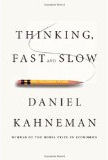Daniel Kahneman, an eminent psychologist, won the 2002 Nobel Prize in economics for his work showing how a key underlying assumption of classical economics — that people behave in an economically rational manner — is demonstrably false. The human brain has evolved cognitive short cuts that served homo sapiens well when survival required rapid decision making but now bias thinking in unproductive ways in the vastly more complex environment of contemporary society. Among these traits, which he explores in his book, “Thinking, Fast and Slow,” are an irrational aversion to risk in some circumstances and a proclivity for excessive optimism in others.
Little did I suspect when I embarked upon reading the book during vacation that passages would bear upon my work at Bacon’s Rebellion. But one section entitled, “The Planning Fallacy,” which describes the tendency to base plans and forecasts upon unrealistic, best-case scenarios, applied directly to a wave of transportation mega-projects, from Rail-to-Dulles to the U.S. 460 upgrade, at various stages in the approval process in Virginia. This optimism bias is a fundamental human affliction, affecting consumers, businesses and government alike. No one is immune. But the most egregious examples come from government.
Kahneman cites a fiasco in which the cost of the new Scottish Parliament building escalated from a £40 million estimate in 1997 to £431 million upon completion in 2004. He also notes a tendency for the cost of rail projects around the world to… well, to run off the rails. In a worldwide survey of projects undertaken over 30 years, the average cost overrun was 45% and passenger forecasts exceeded actual performance by 106%.
Writes Kahneman:
Errors in the initial budget are not always innocent. The authors of unrealistic plans are often driven by the desire to get the plan approved — whether by their superiors or by a client — supported by the knowledge that projects are rarely abandoned unfinished merely because of overruns in costs or completion times. In such cases, the greatest responsibility for avoiding the planning fallacy lies with the decision makers who approve the plan. If they do not recognize the need for an outside view, they commit a planning fallacy.
What decision makers should do, Kahneman writes, is to engage in what he calls “reference class forecasting,” a practice that has been implemented for transportation projects in several countries. “The outside view is implemented by using a large database, which provides information on both plans and outcomes for hundreds of projects all over the world, and can be used to provide statistical information about the likely overruns of cost and time, and about the likely underperformance of projects of different types.”
Reference class forecasting protects decision makers from excessive optimism before approving a project and may help them structure projects in ways that will help prevent cost overruns. The problem with most forecasts is that they are based upon known factors and known “unknowns” but, in the immortal words of former Defense Secretary Donald Rumsfeld, do not incorporate “unknown unknowns.” While any particular unknown may be unlikely to occur, there are so many unknowns that the odds are very high that one of them will occur, often with cascading effects. A well-run organization, says Kahneman, will reward planners for precise execution and punish them for ailing to anticipate difficulties.
That’s all very fine but how does it apply to Virginia? Hopefully, decision makers will learn something from recent experiences in administering rail projects like The Tide in Norfolk and Rail-to-Dulles in Northern Virginia. In both projects, costs outran early cost estimates but public authorities continued pursuing them because once a public project picks up momentum and costs have been sunk into it, politically there is no going back.
Now the McDonnell administration is pushing a slew of expensive bridge and highway mega-projects. Aside from the critical question of whether all of these projects are economically justified — the case for the Charlottesville Bypass is particularly weak — we now get to worry whether the projects will run over budget. The Virginia Department of Transportation is shifting from a project-management methodology in which VDOT designed the projects, bid them out to private contractors and ate the cost overruns, to a new methodology that shifts far more of the responsibility and risk to the private contractors. The theory is impeccable. How the theory will be executed is another matter entirely. It will depend largely upon how tightly the contracts are written.
Unfortunately, Gov. Bob McDonnell will be long gone when the projects he sets into motion are completed and the costs are tallied. By the time we know how well his team did in managing the mega-projects, it will be impossible to hold him accountable — just as his predecessor Tim Kaine has eluded the fallout from the Rail-to-Dulles project that he set into motion. Accountability is the key. Private corporations have evolved mechanisms, however imperfect, for holding their decision makers accountable for successsful management of massive projects. Virginia has yet to do so.



